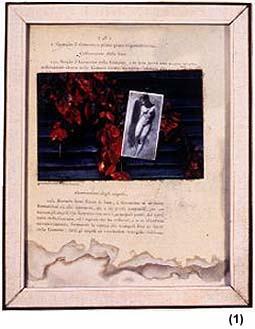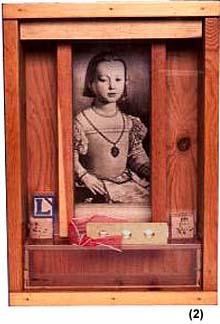WORKS OF "VISUAL POETRY" BY JOSEPH CORNELL
ARE GIVEN TO THE VIRGINIA MUSEUM OF FINE ARTS
 Prominent American Artist's Work
Prominent American Artist's Work
Not Represented in Richmond Before
Twenty collages and "box constructions" by New York artist Joseph Cornell
are on view at the Virginia Museum of Fine Arts. Cornell is represented in all major
U.S. museum collections of 20th century art, and "the Virginia Museum of Fine
Arts is fortunate to be able to fill a notable gap in its great 20th-century holdings,"
says Katharine C. Lee, director of the museum.
Cornell was born in 1903 in Nyack, N.Y. He settled with his family on Long Island
in 1921, and died in Flushing in 1972 - never as an adult having left the New York
City area.
He was insired early in his life bv the exploration of dreams and visions in the
work of the surrealists and by the elevation of common objects in Marcel Duchamp's
sculptures
Cornell "quickly developed a distinctive style, creating what has often been
described as an intensely personal form of visual poetry that is difficult to categorize,"
says Ashley Kistler, assistant curator of 20th-century art at the Virginia Museum
of Fine Arts.
The 20 works by Cornell - dating from the 1950s and '60s - were given to the museum
by the Joseph and Robert Cornell Memorial Foundation of Key Biscayne, Fla. The Virginia
Museum of Fine Arts, which did not own any Comell collages or boxes, is among seven
museums to which the foundation has given works by Comell this year.
 "The Virginia Museum of Fine Arts is indebted
to the Cornell Foundation for this extraordinary gift," Lee says. "Now
for the first time, a preeminent 20th- century American artist is represented in
a significant way at the Virginia Museum of Fine Arts.
"The Virginia Museum of Fine Arts is indebted
to the Cornell Foundation for this extraordinary gift," Lee says. "Now
for the first time, a preeminent 20th- century American artist is represented in
a significant way at the Virginia Museum of Fine Arts.
During his 40-year career, Comell produced what Kistler calls "an important
body of work that has captured the imagination of countless viewers."
Cornell first saw the work of the surrealists in Manhattan in 1931. In particular,
seeing collages by German artist Max Ernsr prompted hirn to begin his own experiments.
His earliest collages were made from black-and-white engravings and woodcuts from
turn-of-the-century books.
No more than a year later, he also began to exhibit three-dimensional works that
led in 1936 to his first signature box constructions. Within a few years, his work
was being shown in major museums including the Wadsworth Atheneum in Hartford, Conn.,
and The Museum of Modem Art in New York City. His work has since been featured in
dozens of exhibitions in the United States and abroad.
Cornell once described his work as "a natural outcome of love for the city."
He made frequent excursions into Manhattan from his home on Utopia Parkway in Flushing
to scour second-hand shops along 42nd Street and Times Square that carried out-dated
newspapers and magazines. He also kept extensive files of photographs, newspaper
clippings and general memorabilia on various personalities, themes and topics.
From this vast storehouse of ephemera - a virtual inventory of the odds and ends
of modern life, sorted into labeled containers in his studio - Comell selected the
objects and images that filled his wood-frmed, glass-fronted boxes," says Kistler.
Kynaston McShine, curator of The Museum of Modem Art's 1980 retrospective, wrote:
"For Cornell, a necklace from Woolworth's had as much value as one from Faberge."
The 20 Comell works given to the Virginia Museum of Fine Arts will be exhibited through
early spring in the Frederick Deane Jr. Gallery.
(1)
Constellations of Autumn, undated, Joseph Cormell.
Phot. Katherine Wetzel, © 1996 Virginia Museum of Fine Arts
(2)
Untitled ( Medici Slot Machine Series ), undated, Joseph Cormell.
Phot. Katherine Wetzel, © 1996 Virginia Museum of Fine Arts


 "The Virginia Museum of Fine Arts is indebted
to the Cornell Foundation for this extraordinary gift," Lee says. "Now
for the first time, a preeminent 20th- century American artist is represented in
a significant way at the Virginia Museum of Fine Arts.
"The Virginia Museum of Fine Arts is indebted
to the Cornell Foundation for this extraordinary gift," Lee says. "Now
for the first time, a preeminent 20th- century American artist is represented in
a significant way at the Virginia Museum of Fine Arts.